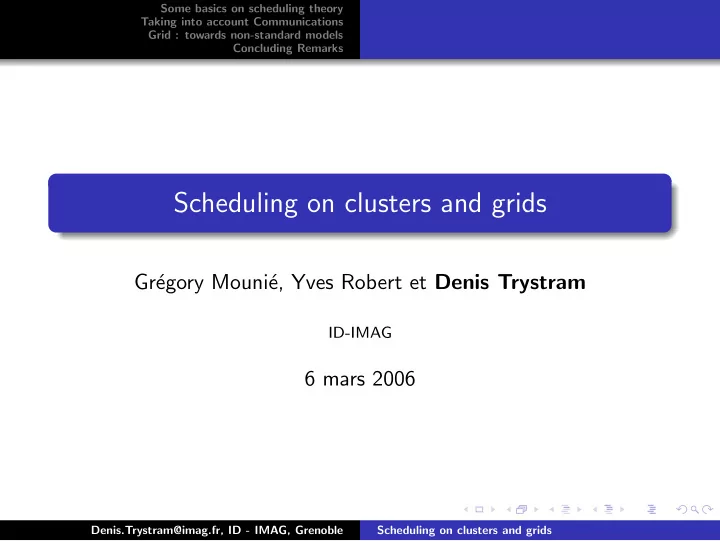

Some basics on scheduling theory Taking into account Communications Grid : towards non-standard models Concluding Remarks Scheduling on clusters and grids Gr´ egory Mouni´ e, Yves Robert et Denis Trystram ID-IMAG 6 mars 2006 Denis.Trystram@imag.fr, ID - IMAG, Grenoble Scheduling on clusters and grids
Some basics on scheduling theory Taking into account Communications Grid : towards non-standard models Concluding Remarks 1 Some basics on scheduling theory Notations and Definitions List scheduling 2 Taking into account Communications Basic Delay Model More sophisticated models 3 Grid : towards non-standard models Parallel tasks Divisible tasks 4 Concluding Remarks Denis.Trystram@imag.fr, ID - IMAG, Grenoble Scheduling on clusters and grids
Some basics on scheduling theory Taking into account Communications Notations and Definitions Grid : towards non-standard models List scheduling Concluding Remarks Basic references Chapitre 3 (Gestion de ressources) ”Informatique R´ epartie”, Trystram, Slimani et Jemni editeurs, Hermes, 2005. Joseph Leung ”Handbook of Scheduling”, Chapman & Hall, 2004 Denis.Trystram@imag.fr, ID - IMAG, Grenoble Scheduling on clusters and grids
Some basics on scheduling theory Taking into account Communications Notations and Definitions Grid : towards non-standard models List scheduling Concluding Remarks Traditional scheduling – Framework Application = DAG G = ( T , E , p ) T = set of tasks E = precedence constraints p ( T ) = computational cost of task T (execution time) c ( T , T ′ ) = communication cost (data sent from T to T ′ ) Platform Set of p (identical) processors Schedule σ ( T ) = date to start the execution of task T π ( T ) = processor assigned to it Denis.Trystram@imag.fr, ID - IMAG, Grenoble Scheduling on clusters and grids
Some basics on scheduling theory Taking into account Communications Notations and Definitions Grid : towards non-standard models List scheduling Concluding Remarks Traditional scheduling – Constraints Data dependencies If ( T , T ′ ) ∈ E then if π ( T ) = π ( T ′ ) then σ ( T ) + p ( T ) ≤ σ ( T ′ ) if π ( T ) � = π ( T ′ ) then σ ( T ) + p ( T ) + c ( T , T ′ ) ≤ σ ( T ′ ) Resource constraints (sequential tasks) π ( T ) = π ( T ′ ) ⇒ [ σ ( T ) , σ ( T ) + p ( T )[ � [ σ ( T ′ ) , σ ( T ′ ) + p = ∅ Denis.Trystram@imag.fr, ID - IMAG, Grenoble Scheduling on clusters and grids
Some basics on scheduling theory Taking into account Communications Notations and Definitions Grid : towards non-standard models List scheduling Concluding Remarks Traditional scheduling – Objective functions Makespan or total execution time C max ( σ ) = max T ∈ T ( σ ( T ) + p ( T )) Other classical objectives : Sum of completion times (with its weighted variant) With arrival times : maximum flow (response time), or sum flow More oriented to fair solutions : maximum stretch, or sum stretch Denis.Trystram@imag.fr, ID - IMAG, Grenoble Scheduling on clusters and grids
Some basics on scheduling theory Taking into account Communications Notations and Definitions Grid : towards non-standard models List scheduling Concluding Remarks Scheduling problem Computational units are identifed and their relations are analyzed. Scheduling Determine when and where computational units will be executed. Denis.Trystram@imag.fr, ID - IMAG, Grenoble Scheduling on clusters and grids
Some basics on scheduling theory Taking into account Communications Notations and Definitions Grid : towards non-standard models List scheduling Concluding Remarks Precedence Task Graph Let G = ( V , E ) be a weighted directed acyclic graph i ff (partial order) The vertices are weighted by the execution times. The arcs are weighted by the data to be transfered from a task to another. Notice that some colleagues are considering variants (bipartite, Data flow, etc..) Denis.Trystram@imag.fr, ID - IMAG, Grenoble Scheduling on clusters and grids
Recommend
More recommend